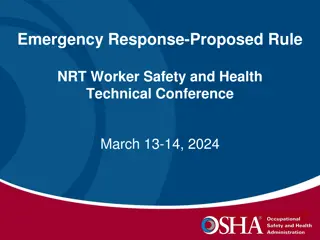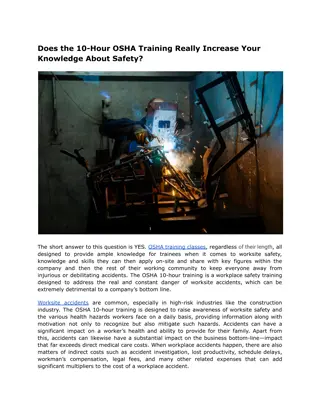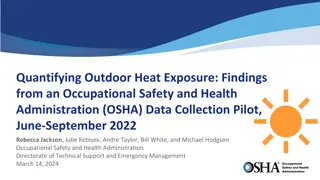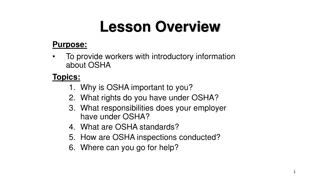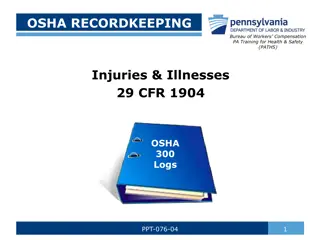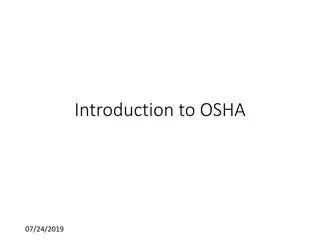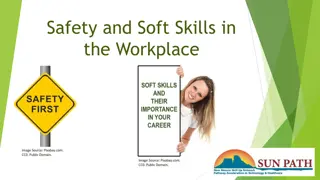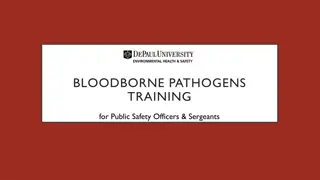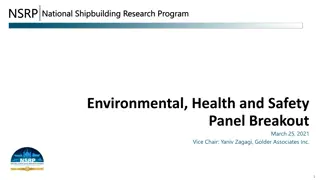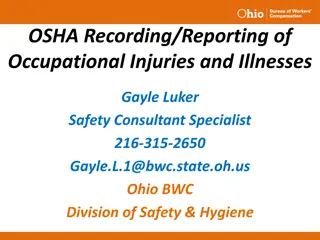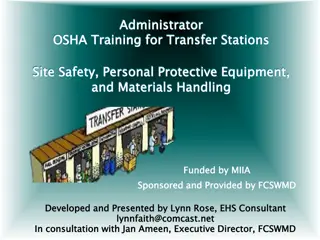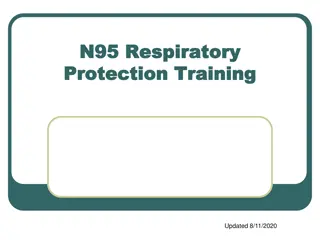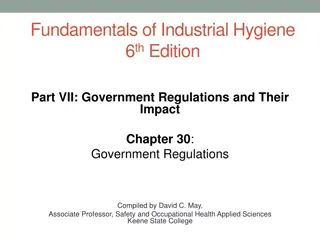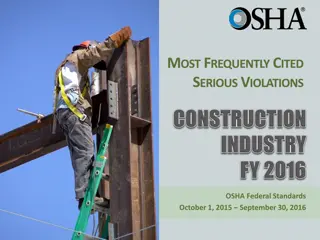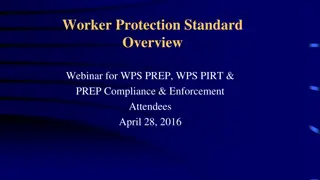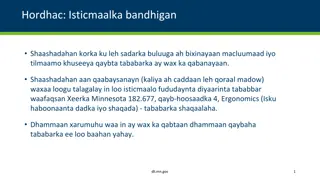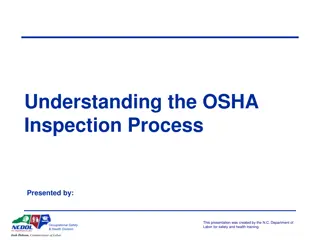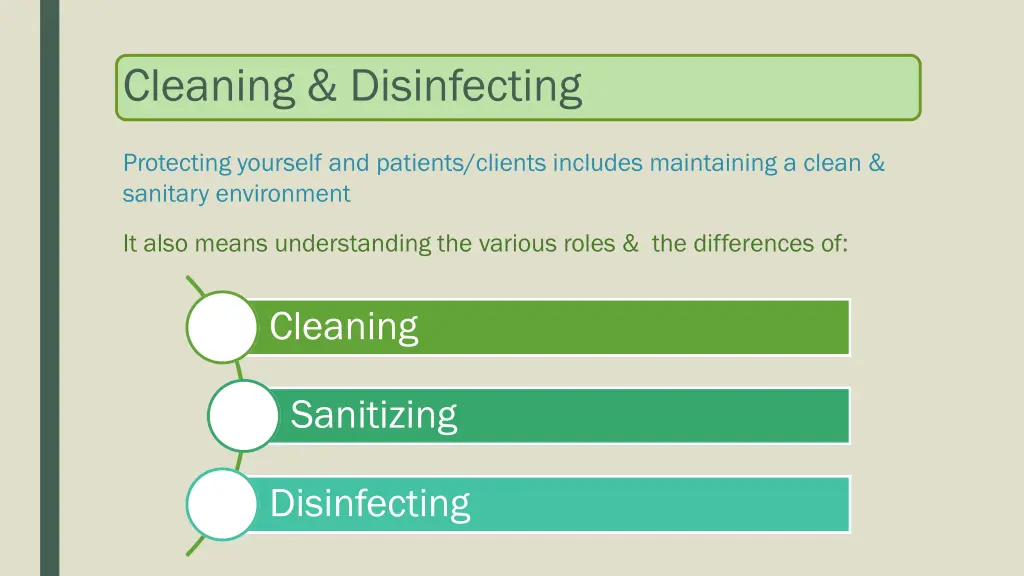
Understand the Differences: Cleaning, Sanitizing, Disinfecting
Learn the distinctions between cleaning, sanitizing, and disinfecting to maintain a clean and safe environment for yourself and clients. Discover the roles each process plays in removing germs and reducing the risk of infection.
Download Presentation

Please find below an Image/Link to download the presentation.
The content on the website is provided AS IS for your information and personal use only. It may not be sold, licensed, or shared on other websites without obtaining consent from the author. If you encounter any issues during the download, it is possible that the publisher has removed the file from their server.
You are allowed to download the files provided on this website for personal or commercial use, subject to the condition that they are used lawfully. All files are the property of their respective owners.
The content on the website is provided AS IS for your information and personal use only. It may not be sold, licensed, or shared on other websites without obtaining consent from the author.
E N D
Presentation Transcript
Cleaning & Disinfecting Protecting yourself and patients/clients includes maintaining a clean & sanitary environment It also means understanding the various roles & the differences of: Cleaning Sanitizing Disinfecting
Cleaning & Disinfecting Disinfecting Cleaning Sanitizing Disinfecting kills germs surfaces or objects. kills germs on Cleaning removes germs removes germs, dirt, and impurities from surfaces or objects. Cleaning works by using soap (or detergent) and water to physically remove germs from surfaces. Does not necessarily kill germs, but by removing them, it lowers their numbers & risk of infection. Note: broken glassware, which may or may not be contaminated, shall not be picked up directly with hands. Use a brush, dustpan, tongs, forceps, etc Sanitizing lowers the number of lowers the number of germs germs on surfaces or objects to a safe level, as judged by public health standards or requirements. Disinfecting works by using chemicals, disinfectants, to kill germs on surfaces or objects. This process does not necessarily clean dirty surfaces or remove germs, but by killing germs on a surface after cleaning, it can further lower the risk of spreading infection. This process works by either cleaning or disinfecting cleaning or disinfecting surfaces or objects to lower the risk of spreading infection. either
Cleaning & Disinfecting If a product makes a claim to kill a microbe or pathogen it must go through the Environmental Protection Agency s (EPA) Pesticide Registration process. Out of Stock Antimicrobial Pesticide EPA Registration Number Typically displayed as EPA Reg No The first set of digits first set of digits is the registration number for the company that holds registration for that product The second set of digits second set of digits identifies a specific product of the company If there is a third set of digits a third set of digits, it is the Distributor ID number. This represents that the product is a distributor product with identical formulation and efficacy as the primary product, but often the brand name differs EPA Reg No If your supplier or distributor states they are Out of Stock of your preferred product, refer to the EPA Reg No listed on the bottle Ignore the brand name and label design, so long as the first two sets of numbers following EPA Reg No are the exact same, the products are equivalent: An antimicrobial pesticide is intended to disinfect, sanitize, reduce, or mitigate growth or development of microbiological organisms or protect inanimate objects, industrial processes or systems, surfaces, water, or other chemical substances from contamination, fouling, or deterioration caused by bacteria, viruses, fungi, protozoa, algae, or slime. EPA Reg No 12345-12 EPA Reg No 12345-12-345 EPA Reg No 12345-12-889 are all the exact same product
Cleaning & Disinfecting At minimum, the disinfectant you choose shall be registered with the EPA and be indicated for HIV and HBV destruction However, as mentioned before, any disinfect that can kill TB can also kill HIV & HBV The EPA publishes lists of registered antimicrobial products organized by common pathogens, for example: List D: indicated for HIV-1, HBV List E: indicated for TB, HIV-1, HBV List N: indicated for SARS-CoV-2 (COVID-19) EPA s Pesticide Product and Label System (PPLS) can provide additional information, it is also searchable by: EPA Registration No Product/Brand/Company Active Chemical Name
Cleaning & Disinfecting
Cleaning & Disinfecting Your facility will likely require more than one disinfectant since no single product will be best for all uses, consider: General surfaces Instruments Many disinfectants need to stay on surfaces for a specific amount of time to fully disinfect the surface before being wiped down. The instructions included with the disinfectant should note the amount of time needed to properly disinfect an The material of these surfaces vary, not all disinfectants will be ideal, consult manufacturer care instructions & the SDS area. Note: All chemicals must come with Safety Data Sheets (SDS) formerly known as Material Safety Data Sheets (MSDS)
Cleaning & Disinfecting Employers shall ensure that the worksite is maintained in a clean and sanitary condition. The employer shall determine and implement an appropriate written schedule for cleaning and method of decontamination based upon the location within the facility, type of surface to be cleaned, type of soil present, and tasks or procedures being performed in the area. All equipment and environmental and working surfaces shall be cleaned and decontaminated after contact with blood or other potentially infectious materials. 1910.1030(d)(4) Housekeeping Contaminated work surfaces shall be decontaminated with an appropriate disinfectant after completion of procedures; immediately or as soon as feasible when surfaces are overtly contaminated or after any spill of blood or other potentially infectious materials; and at the end of the work shift if the surface may have become contaminated since the last cleaning. Protective coverings, such as plastic wrap, aluminum foil, or imperviously-backed absorbent paper used to cover equipment and environmental surfaces, shall be removed and replaced as soon as feasible when they become overtly contaminated or at the end of the workshift if they may have become contaminated during the shift.
Cleaning & Disinfecting All bins, pails, cans, and similar receptacles intended for reuse which have a reasonable likelihood for becoming contaminated with blood or other potentially infectious materials shall be inspected and decontaminated on a regularly scheduled basis and cleaned and decontaminated immediately or as soon as feasible upon visible contamination. Broken glassware which may be contaminated shall not be picked up directly with the hands. It shall be cleaned up using mechanical means, such as a brush and dust pan, tongs, or forceps. 1910.1030(d)(4) Housekeeping Protective coverings, such as plastic wrap, aluminum foil, or imperviously-backed absorbent paper used to cover equipment and environmental surfaces, shall be removed and replaced as soon as feasible when they become overtly contaminated or at the end of the workshift if they may have become contaminated during the shift. Reusable sharps that are contaminated with blood or other potentially infectious materials shall not be stored or processed in a manner that requires employees to reach by hand into the containers where these sharps have been placed.
Regulated Waste BIOHAZARD Symbol
Regulated Waste Regulated Other Regulated Sharps Regulated Other Used needles, etc Liquid/semi-liquid blood Items contaminated All sharps are disposed or OPIM with blood or OPIM & of in a Sharps Container Items caked with dried which would release whether or not they blood or OPIM & these substances in a touched blood or other capable of releasing liquid or semi-liquid potentially infectious these materials during state if compressed material (OPIM) handling Pathological & microbiological wastes containing blood or OPIM
*image next slide Regulated Waste For Sharps Waste: Container Labeling Container Design Container Usage Must Be: BIOHAZARDOUS WASTE BIOHAZARDOUS WASTE Must Be: rigid & puncture within arm s reach in or SHARPS WASTE SHARPS WASTE resistant & portable procedure area shall be written on appropriate containers, and shall; leakproof on sides & replaced at 2/3 3/4 bottom full have the biohazard symbol be fluorescent orange or orange-red or predominantly so with lettering & symbols in contrasting color be an integral part of the container closeable & sealable always maintained sharps waste specific upright incapable of reopening without great difficulty commercially available
Regulated Waste Occupational exposure to bloodborne pathogens from needlesticks and other sharps injuries is a serious problem, resulting in approximately 385,000 needlesticks and other sharps- related injuries to hospital-based healthcare personnel each year. Similar injuries occur in other healthcare settings, such as nursing homes, clinics, emergency care services, and private homes. Sharps injuries are primarily associated with occupational transmission of hepatitis B virus (HBV), hepatitis C virus (HCV), and human immunodeficiency virus (HIV), but they have been implicated in the transmission of more than 20 other pathogens. A Sharps Container is a puncture-resistant and leak-proof container with a one-way top that is designed for the disposal of sharps; required and regulated by the Occupational Safety and Health Administration (OSHA).
BBP Standard 1910.1030(d)(4) Regulated Waste Contaminated sharps shall be discarded immediately or as soon as feasible in containers that are: Closable; Puncture resistant; Leakproof on sides and bottom; and Labeled or color-coded in accordance with this standard.
BBP Standard 1910.1030(d)(4) Regulated Waste During use, containers for contaminated sharps shall be: Easily accessible to personnel and located as close as is feasible to the immediate area where sharps are used or can be reasonably anticipated to be found Maintained upright throughout use; and Replaced routinely and not be allowed to overfill.
BBP Standard 1910.1030(d)(4) Regulated Waste When moving containers of contaminated sharps from the area of use, the containers shall be: Closed immediately prior to removal or replacement to prevent spillage or protrusion of contents during handling, storage, transport, or shipping; Placed in a secondary container if leakage is possible. The second container shall be: Closable; Constructed to contain all contents and prevent leakage during handling, storage, transport, or shipping; and Labeled or color-coded according this standard. Reusable containers shall not be opened, emptied, or cleaned manually or in any other manner which would expose employees to the risk of percutaneous injury.
BBP Standard 1910.1030(d)(4) Regulated Waste Regulated waste shall be placed in containers which are: Closable; Constructed to contain all contents and prevent leakage of fluids during handling, storage, transport or shipping; Labeled or color-coded in accordance with this standard; and Closed prior to removal to prevent spillage or protrusion of contents during handling, storage, transport, or shipping.
BBP Standard 1910.1030(d)(4) Regulated Waste If outside contamination of the regulated waste container occurs, it shall be placed in a second container. The second container shall be: Closable; Constructed to contain all contents and prevent leakage of fluids during handling, storage, transport or shipping; Labeled or color-coded in accordance with this standard; and Closed prior to removal to prevent spillage or protrusion of contents during handling, storage, transport, or shipping.
BBP Standard 1910.1030(d)(4) Regulated Waste Disposal of all regulated waste shall be in accordance with applicable regulations of the United States, States and Territories, and political subdivisions of States and Territories. Contaminated Sharps Discarding & Containment Other Regulated Waste Containment

